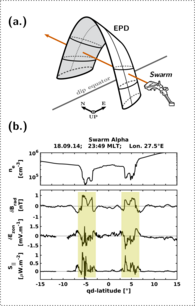Diese Seite ist leider nur in englischer Sprache verfügbar.

After local sunset, the ionospheric F region becomes highly unstable at low magnetic latitudes due to a sudden decrease in plasma density at lower altitudes (E region). The mutually perpendicular combination of such a steep vertical plasma density gradients, the ambient magnetic field, and zonal currents driven by gravity or a background electric field generate interchange instabilities. They evolve as depleted density structures aligned with the magnetic field, extending in latitude from one magnetic hemisphere to the other and altitude from the bottom side F region up to 2000 km, approximately (Figure a). The depleted structures are commonly known as equatorial plasma depletions (EPD). Plasma irregularities associated with EPDs deteriorate the quality of the signals of telecommunication satellites as well as of those of remote sensing, weather, and scientific satellites. They also affect the accuracy of navigation systems generating a loss of the signal (e.g., Xiong et al., 2016). Currently, the global seasonal-longitudinal distribution of EPD is well known (e.g., Stolle et al., 2008), but the day-to-day variability of their occurrence is still subject to research.
This project aims at improving our knowledge of the electrodynamics of EPDs by evaluating variations of their electromagnetic signatures using high-resolution in-situ measurements of the Swarm mission (Figure b). By using magnetic and electric field data, we were able to determine the preferable direction of the EPD-related Poynting flux (Rodriguez-Zuluaga et al., 2017) (see Figure b). Differently than predicted by theoretical approaches, both field-aligned currents and Poynting flux were observed to be interhemispheric, and the flow directions show a well-defined seasonal and longitudinal dependence (Rodriguez-Zuluaga & Stolle, 2019). We have also compared Swarm observations with results from physics-based models (Yokoyama and Stolle, 2017), and could well reproduce the amplitudes of associated electric currents. Furthermore, we have reported that EPDs present lower or higher plasma pressure than the ambient. For lowpressure EPDs the plasma pressure gradients are mostly dominated by variations of the plasma density so that variations of the temperature are negligible.
High-pressure EPDs suggest significant temperature variations with magnitudes of approximately twice the ambient. Since their occurrence is more frequent in the vicinity of the South Atlantic magnetic anomaly, such high temperatures are suggested to be due to particle precipitation (Rodriguez-Zuluaga et al., 2019). The study corresponds to the first observational evidence of high plasma pressure in regions of low plasma density in the ionosphere.
We further want to improve our understanding of the EPD’s underlying physics by analyzing extended Swarm data sets allowing for a better seasonal and local time coverage, adding dedicated simulations by physics-based models, and low latitude radar observations, e.g., from Jicamarca observatory. We will further analyze high-cadence electron density and magnetic field records by Swarm and relate it to GPS observations to identify the scattering conditions that cause scintillations. Thus, we make full use of the multi-instrument capabilities of the Swarm mission.
By addressing the questions above with multiple parameter data sets, we expect new, fundamental insights into the electromagnetic mechanisms of the upper atmosphere as well as significant advances in our ability to describe and forecast EPDs and, finally, to mitigate their impact on radio wave propagation associated with technological infrastructure like GPS.
Laufzeit
2016 - 2022
Zuwendungsgeber
DFG, Priority Programme 1788 “DynamicEarth”
Projektverantwortlicher
Dr. Claudia Stolle (GFZ Potsdam)
Projektmitarbeiter
Juan S. Rodriguez-Zuluaga (GFZ Potsdam)
Publikationen
- Rodríguez-Zuluaga, J., Stolle, C., Yamazaki, Y., Lühr, H., Park, J., Scherliess, L., Chau, J. L. (2019), On the balance between plasma and magnetic pressure across equatorial plasma depletions, Journal of Geophysical Research, 124, 7, pp. 5936-5944, http://doi.org/10.1029/2019JA026700
- Rodríguez-Zuluaga, J. and Stolle, C. (2019), Interhemispheric field-aligned currents at the edges of equatorial plasma depletions, Scientific Reports, 9, 1233, http://doi.org/10.1038/s41598-018-37955-z
- Wan, X., Xiong, C., Rodríguez-Zuluaga, J., Kervalishvili, G., Stolle, C., Wang, H. (2018), Climatology of the Occurrence Rate and Amplitudes of Local Time Distinguished Equatorial Plasma Depletions Observed by Swarm Satellite, Journal of Geophysical Research, 123, 3014-3026, http://doi.org/10.1002/2017JA025072
- Rodríguez-Zuluaga, J., Stolle, C., and Park, J. (2017), On the direction of the Poynting flux associated with equatorial plasma depletions as derived from Swarm, Geophys. Res. Lett., 44, 5884–5891, https://doi.org/10.1002/2017GL073385
- Stolle, C., Lühr, H., and Fejer, B.G. (2008), Relation between the occurrence rate of ESF and the equatorial vertical plasma drift velocity at sunset derived from global observations, Annales Geophysicae, 26, 12, 3979-3988, https://doi.org/10.5194/angeo-26-3979-2008
- Xiong, C., Stolle, C., and Lühr, H. (2016), The Swarm satellite loss of GPS signal and its relation to ionospheric plasma irregularities, Space Weather, 14, 563–577, https://doi.org/10.1002/2016SW001439
- Yokoyama, T. and Stolle, C. (2017), Low and midlatitude ionospheric plasma density irregularities and their effects on geomagnetic field. Space Sci. Rev. 27(5), 1821-1830, https://doi.org/10.1007/s11214-016-0295-7

